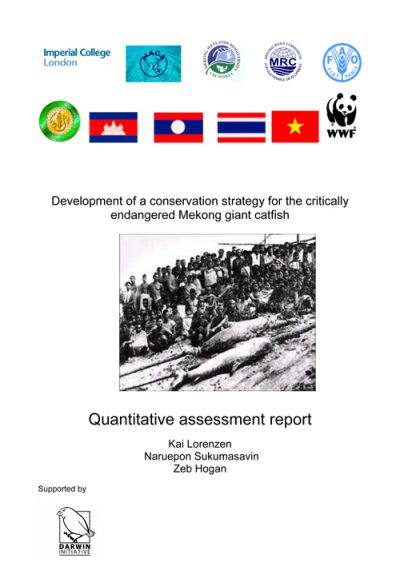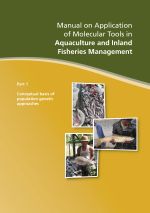Development of a conservation strategy for the critically endangered Mekong giant catfish: Quantitative assessment report
22 April 2008 | Kai Lorenzen, Naruepon Sukumasavin and Zeb Hogan | 471 Downloads | .pdf | 1.39 MB | Freshwater finfish, Genetics and Biodiversity, Cambodia, Lao PDR, Thailand, Vietnam
The Mekong giant catfish (MGC), one of the world's largest freshwater fish and a charismatic animal revered throughout the Mekong region, is considered critically endangered (IUCN Red List 2003). A range of conservation initiatives for the giant catfish are being carried out. The present report aims to assess the conservation status of Mekong Giant Catfish, and to evaluate the likely effectiveness of different conservation measures.
Detailed data collected intermittently since the late 1960s were synthesised and analysed through confrontation with a mathematical model. The following assumptions underlie the baseline model:
- MGC in the Mekong basin form a single population (all catches have been taken from the same population).
- The full population is vulnerable to fishing (there are no un-fished and thus, unobserved local populations).
- Reporting of MGC catches is near-complete and not size-biased (There is no unreported harvest of small MGC).
History of exploitation and environmental change
Historically, targeted giant catfish fishing has always been a special event with spiritual associations. Exploitation seems to have been stable or characterised by boom and bust cycles. It is unlikely that high catches of MGC have been sustained in the recent past (the last 100-200 years). In the 1970s, catches appear to have been stable at an average of about 20 fish per year. Catches increased substantially, up to a maximum of 80 per year in the late 1980s, driven mainly by a high profile government-supported fishery in Chiang Khong (Northern Thailand). Both catch and catch per unit of effort (CPUE) declined strongly in the 1990s. This was followed by a decline in effort, most likely attributable to the reduced profitability of fishing as well as the development of alternative economic opportunities. Environmental change in the Mekong basin has been gradual and of moderate magnitude until the very recent past. More dramatic changes may have occurred in the very recent past with rapid blasting and the commissioning of several dams in the upper river, but any effects of these changes on the giant catfish population would not yet be visible in the fisheries data. It thus appears that fishing can be identified as the main driver of past changes in population abundance and structure.
Population status
Reconstructed spawner abundance was relatively stable at about 250 animals prior to 1983 (11- 71% of unexploited abundance). The population then declined dramatically to just 50 spawners in 1995 (2-14% of unexploited abundance). The Chiang Khong fishing boom thus reduced spawner abundance by about 80% in just ten years. The population has since recovered to about 145 animals (7-40% of unexploited abundance) by 2006. Much of this predicted recovery is based on maturation of fish that were spawned about 20 years previously, and would occur even if for any reason reproduction had failed in the recent past. The spawner population in the absence of fishing on recruited MGC is estimated at about 355- 2200 fish. The maximum sustainable catch is uncertain, but likely to be between 20-40 fish per year. Higher catches can be obtained temporarily, but would lead to a decline in abundance and CPUE. It is possible that episodes of overfishing followed by fishery decline and population recovery may have occurred repeatedly in history. The extent to which small juveniles (< 100 cm length) are subject to exploitation remains unknown. If juvenile harvesting had been significant in the 1970s, the unexploited spawner abundance and sustainable yield from the population could be substantially higher than estimated here.
Recommendations
Habitat and environmental change in the Mekong basin has been gradual and of moderate magnitude until the very recent past, and it is unlikely that this has been a significant factor in past population change. More dramatic changes may have occurred in the very recent past (with 'rapid blasting and the commissioning of several dams in the upper river), and this trend is likely to continue in the future. Maintaining the overall Mekong ecosystem (flows, physical habitats and connectivity) clearly is important to ensuring the long-term survival of the species in the wild. Given that habitat use and migration patterns of the species are largely unknown, no essential habitat can be identified except for the spawning area. The spawning area is very likely to be located within some 50 miles north of Chiang Khong, and it can be clearly identified as essential habitat. An immediate priority should be to protect this habitat.
The captive population of MGC maintained by the Thai Department of Fisheries provides a vital insurance, safeguarding the survival of the species should it become extinct in the wild. The captive population should be managed carefully so as to conserve its genetic diversity, should re-introduction become necessary. For the time being, captive-bred fish should not be released into the Mekong or its tributaries, for two reasons: (a) The wild population is likely to recover naturally, unless there have been recent and as yet unknown negative effects on recruitment. Releases would have no net benefit but may partially replace wild fish through ecological interactions. (b) Despite of good hatchery management developmental and genetic responses to the culture environment are likely to result in the captive-bred fish being less fit than their wild conspecifics, and reproductive interactions between the wild and captive-bred population segments may reduce spawning success or the survival of offspring. It should be noted that, because the wild population carrying capacity appears to be quite low, releases of even low numbers of captive-bred fish can have significant impacts on the wild population.
Interactions with cultured fish are unlikely to have played a significant role in past population change, but may become a major issue in the future due to both intentional and accidental releases. At present the cultured population is likely to exceed the wild population in abundance. Escapes of MGC grown in commercial aquaculture could pose a significant threat to the wild population. Measures should be taken to minimise the risk of such escapes occurring. It should be noted that, because the wild population carrying capacity appears to be quite low, releases of even low numbers of captive-bred fish can have significant impacts on the wild population.
Publisher: Network of Aquaculture Centres in Asia-Pacific
Rights: Creative Commons Attribution.

